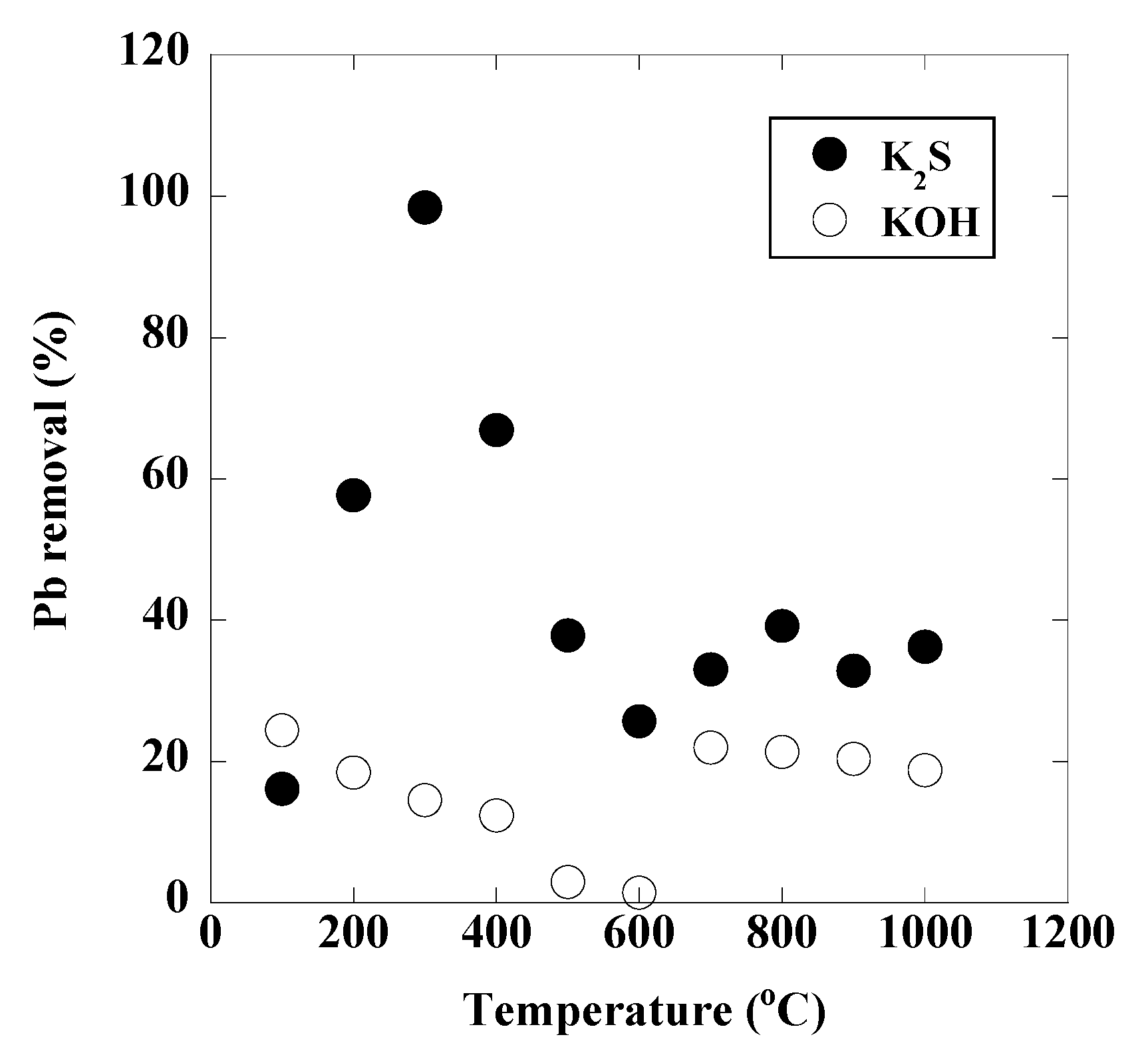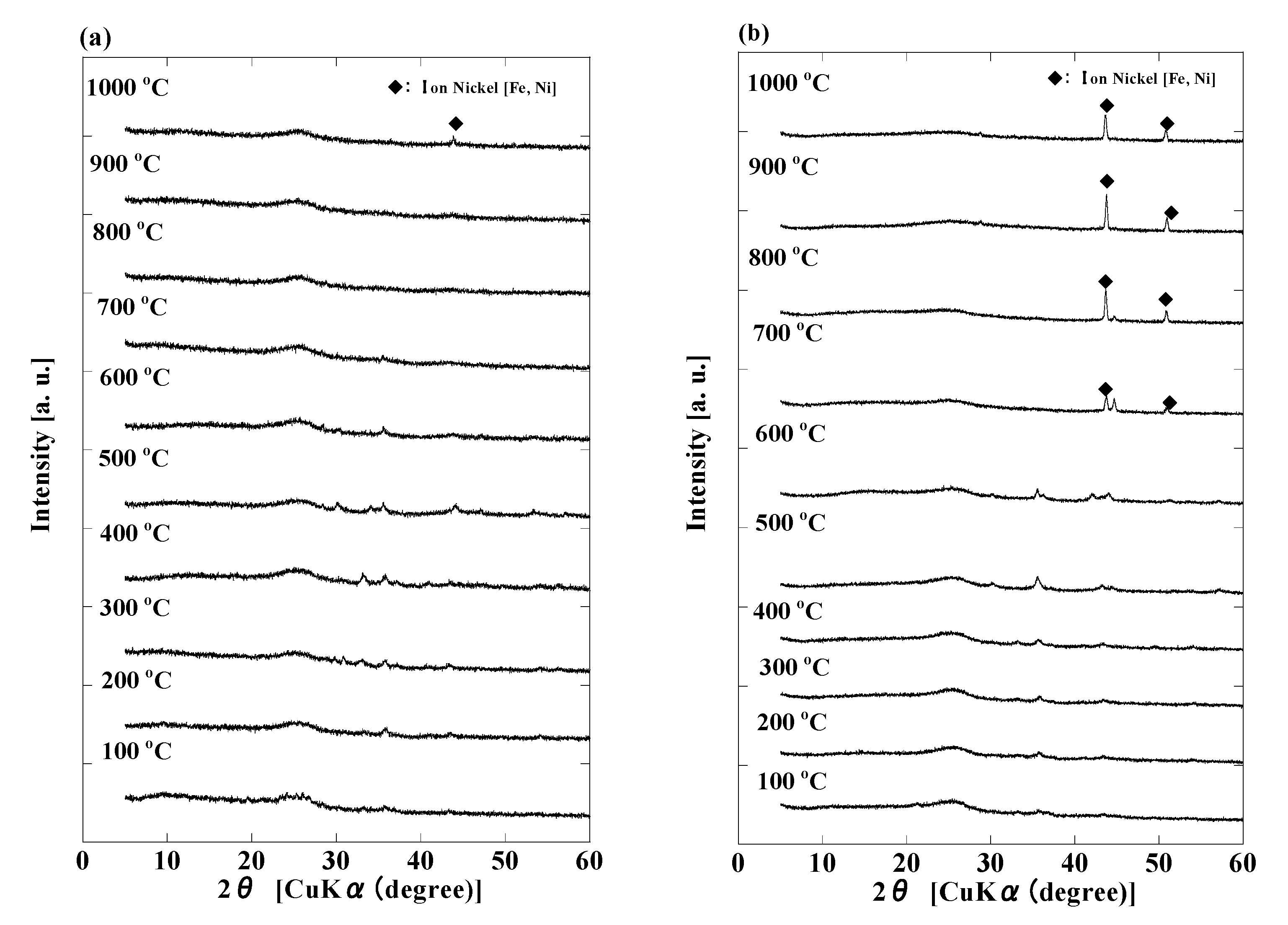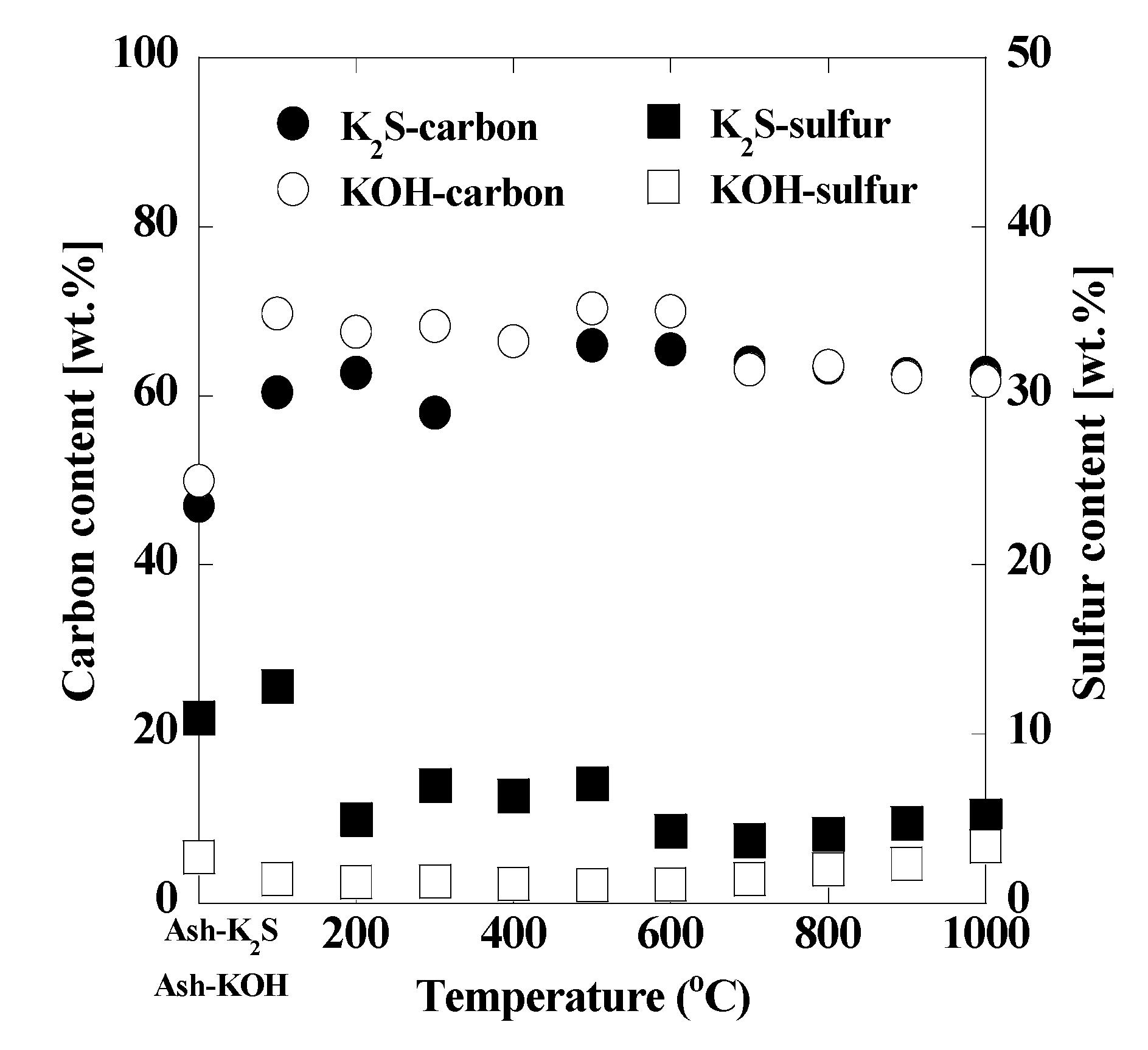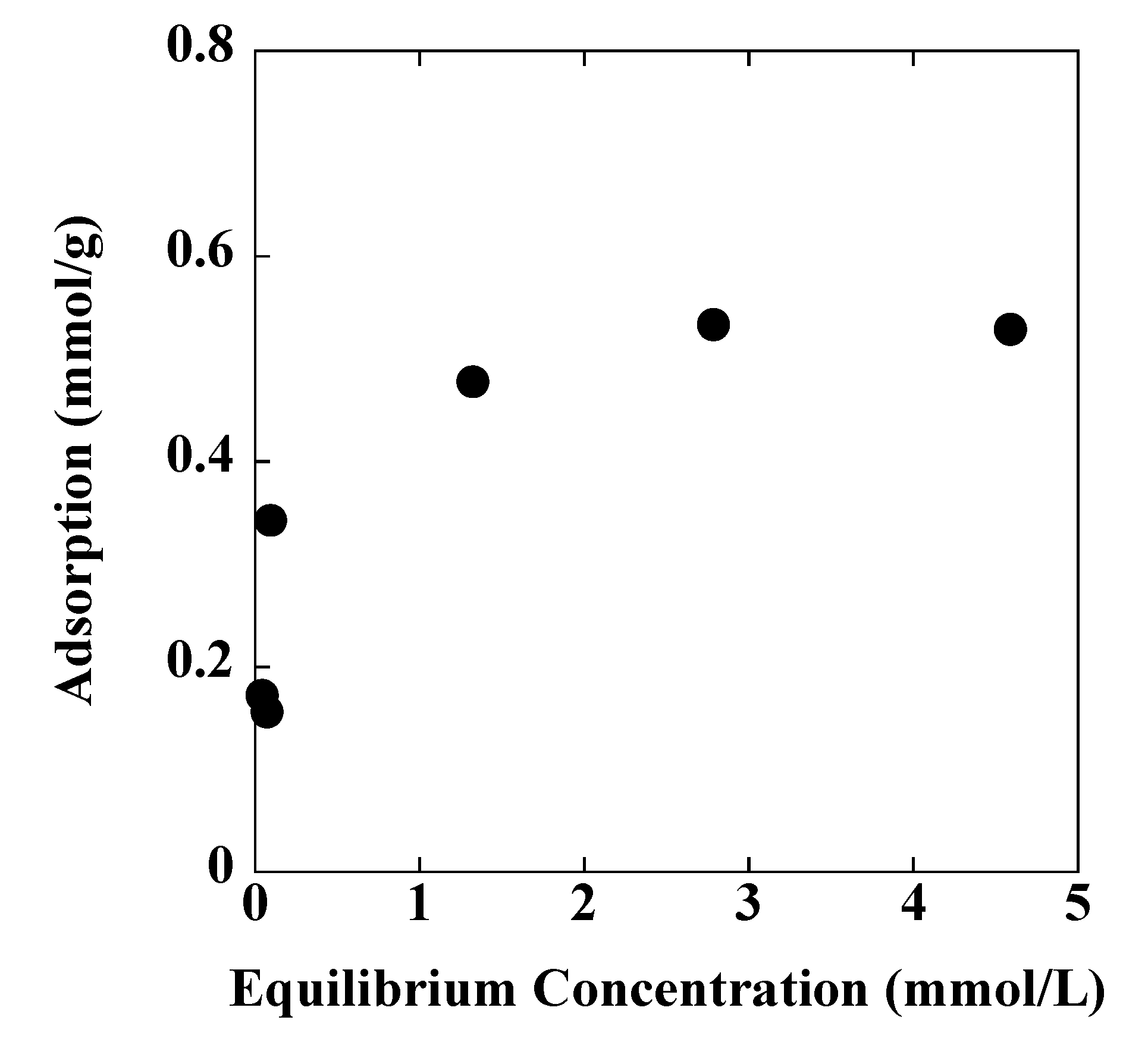Carbonaceous Adsorbent Derived from Sulfur-Impregnated Heavy Oil Ash and Its Lead Removal Ability from Aqueous Solution
Abstract
:1. Introduction
2. Materials and Methods
2.1. Heavy Oil Ash
2.2. Preparation of Adsorbent
2.3. Lead Removal
2.4. Characterization
3. Results and Discussion
4. Conclusions
Funding
Conflicts of Interest
References
- Amer, A.M. Processing of Egyptian boiler-ash for extraction of vanadium and nickel. Waste Manag. 2002, 22, 515–520. [Google Scholar] [CrossRef]
- Tsai, S.-L.; Tsai, M.-S. A study of the extraction of vanadium and nickel in oil-fired fly ash. Resour. Conserv. Recycl. 1998, 22, 163–176. [Google Scholar] [CrossRef]
- Hsieh, Y.-M.; Tsai, M.-S. Physical and chemical analyses of unburned carbon from oil-fired fly ash. Carbon 2003, 41, 2317–2324. [Google Scholar] [CrossRef]
- Caramuscio, P.; De Stefano, L.; Seggiani, M.; Vitolo, S.; Narducci, P. Preparation of activated carbons from heavy-oil ash. Waste Manag. 2003, 23, 345–351. [Google Scholar] [CrossRef]
- Seggiani, M.; Vitolo, S.; Narducci, P. Investigation on the porosity development by CO2 activation in heavy oil ashes. Fuel 2003, 82, 1441–1450. [Google Scholar] [CrossRef]
- Seggiani, M.; Vitolo, S.; Filippis, P.D. Effect of pre-oxidation on the porosity development in a heavy oil fly ash by CO2 activation. Fuel 2005, 84, 1593–1596. [Google Scholar] [CrossRef]
- Adhoum, N.; Monser, L. Removal of cyanide from aqueous solution using impregnated activated carbon. Chem. Eng. Process. 2002, 41, 17–21. [Google Scholar] [CrossRef]
- Sadraei, R.; Paganini, M.C.; Calza, P.; Magnacca, G. An easy synthesis for preparing bia-based hybrid adsorbent useful for fast adsorption of polar pollutants. Nanomaterials 2019, 9, 731. [Google Scholar] [CrossRef]
- Magnacca, G.; Santos, F.N.D.; Sadraei, R. Bio-based substances from compost as reactant and active phase for selective capture of cationic pollutants from waste water. Front. Chem. 2020, 8, 550. [Google Scholar] [CrossRef]
- Volkan, M.; Ataman, A.; Howard, A. Pre-concentration of some trace metals from sea water on a mercapto-modified silica gel. Analyst 1987, 112, 1409–1412. [Google Scholar] [CrossRef]
- Krishnan, K.A.; Anirudhan, T.S. Removal of cadmium(II) from aqueous solutions by steam-activated sulphurised carbon prepared from sugar-cane bagasse pith: Kinetics and equilibrium studies. Water SA 2003, 29, 147–156. [Google Scholar] [CrossRef] [Green Version]
- Gomez-Serrano, V.; Macias-Garcia, A.; Espinosa-Mansilla, A.; Valenzuela-Calahorroc, C. Adsorption of mercury, cadmium and lead from aqueous solution on heat-treated and sulphurized activated carbon. Water Res. 1998, 32, 1–4. [Google Scholar] [CrossRef]
- Wajima, T. A new carbonaceous adsorbent for heavy metal removal from aqueous solution prepared from paper sludge by sulfur-impregnation and pyrolysis. Process Saf. Environ. Prot. 2017, 112, 342–352. [Google Scholar] [CrossRef]
- Pearson, R.G. Hard and soft acids and bases. J. Am. Chem. Soc. 1963, 85, 3533–3539. [Google Scholar] [CrossRef]
- Pearson, R.G. Recent advances in the concept of hard and soft acids and bases. J. Chem. Educ. 1987, 64, 561–567. [Google Scholar] [CrossRef]
- Zhao, D.; Gao, X.; Wu, C.; Xie, R.; Feng, S.; Chen, C. Facile preparation of amino functionalized graphene oxide decorated with Fe2O3 nanoparticles for the adsorption of Cr (IV). Appl. Surf. Sci. 2016, 384, 1–9. [Google Scholar] [CrossRef]
- Erdem, M.; Ozverdi, A. Lead adsorption from aqueous solution onto siderite. Sep. Purif. Technol. 2005, 42, 259–264. [Google Scholar] [CrossRef]
- Adebowale, K.O.; Unuabonah, I.E.; Olu-Owolabi, B.I. The effect of some operating variables on the adsorption of lead and cadmium ions on kaolinite clay. J. Hazard. Mater. 2006, 134, 130–139. [Google Scholar] [CrossRef]
- Feng, Q.; Lin, Q.; Gong, F.; Sugita, S.; Shoya, M. Adsorption of lead and mercury by rice husk ash. J. Colloid Interface Sci. 2004, 278, 1–8. [Google Scholar] [CrossRef]
- Huang, Y.H.; Hsueh, C.L.; Huang, C.P.; Su, L.C.; Chen, C.Y. Adsorption thermodynamic and kinetic studies of Pb (II) removal from water onto a versatile Al2O3-supported iron oxide. Sep. Purif. Technol. 2007, 55, 23–29. [Google Scholar] [CrossRef]
- Vuković, G.D.; Marinković, A.D.; Škapin, S.D.; Ristić, M.T.; Aleksić, R.; Perić-Grujić, A.A.; Uskoković, P.S. Removal of lead from water by amino modified multi-walled carbon nanotubes. Chem. Eng. J. 2011, 173, 855–865. [Google Scholar] [CrossRef]
- Saha, D.; Barakat, S.; Bramer, S.E.V.; Nelson, K.A.; Hensley, D.K.; Chen, J. Noncompetitive and competitive adsorption of heavy metals in sulfur-functionalized ordered mesoporous carbon. ACS Appl. Mater. Interfaces 2016, 8, 34132–34142. [Google Scholar] [CrossRef] [PubMed]
- Imamoglu, M.; Tekir, O. Removal of copper (II) and lead (II) ions from aqueous solutions by adsorption on activated carbon from a new precursor hazelnut husks. Desalination 2008, 228, 108–113. [Google Scholar] [CrossRef]
- Abdulkarim, M.; Al-Rub, F.A. Adsorption of lead ions from aqueous solution onto activated carbon and chemically-modified activated carbon prepared from date pits. Adsorp. Sci. Technol. 2004, 22, 119–134. [Google Scholar] [CrossRef]
- Brown, P.; Jefcoat, I.A.; Parrish, D.; Gil, S.; Graham, E. Evaluation of the adsorptive capacity of peanut hull pellets for heavy metals in solution. Adv. Environ. Res. 2000, 4, 19–29. [Google Scholar] [CrossRef]
- Johns, M.M.; Marshall, W.E.; Toles, C.A. Agricultural by-products as granular activated carbons for adsorbing dissolved metals and organics. J. Chem. Technol. Biotechnol. 1998, 71, 131–140. [Google Scholar] [CrossRef]
- Vilar, V.J.P.; Botelho, C.M.S.; Boaventura, R.A.R. Influence of pH, ionic strength and temperature on lead biosorption by Gelidium and agar extraction algal waste. Process Biochem. 2005, 40, 3267–3275. [Google Scholar] [CrossRef]
- Bansode, R.R.; Losso, J.N.; Marshall, W.E.; Rao, R.M.; Portier, R.J. Adsorption of metal ions by pecan shell-based granular activated carbons. Bioresour. Technol. 2003, 89, 115–119. [Google Scholar] [CrossRef]
- Kikuchi, Y.; Qian, Q.; Machida, M.; Tatsumoto, H. Effect of ZnO loading to activated carbon on Pb (II) adsorption from aqueous solution. Carbon 2006, 44, 195–202. [Google Scholar] [CrossRef]
- Issabayeva, G.; Aroua, M.K.; Sulaiman, N.M.N. Removal of lead from aqueous solutions on palm shell activated carbon. Bioresour. Technol. 2006, 97, 2350–2355. [Google Scholar] [CrossRef]
- Li, Q.; Yu, J.; Zhou, F.; Jiang, X. Synthesis and characterization of dithiocarbamate carbon nanotubes for the removal of heavy metal ions from aqueous solutions. Colloids Surf. A 2015, 482, 306–314. [Google Scholar] [CrossRef]
- Jing, X.; Liu, F.; Yang, X.; Ling, P.; Li, L.; Long, C.; Li, A. Adsorption performances and mechanisms of the newly synthesized N, N′-di(carboxymethyl) dithiocabamate chelating resin toward divalent heavy metal ions from aqueous media. J. Hazard. Mater. 2009, 167, 589–596. [Google Scholar] [CrossRef] [PubMed]









| Raw Ash | |
|---|---|
| Proximate analysis (wt% dry basis) | |
| Volatile matter 1 | 19.0 |
| Fixed carbon | 73.3 |
| Ash | 7.7 |
| Ultimate analysis (wt% dry ash free) | |
| Carbon | 79.5 |
| Hydrogen | 1.2 |
| Nitrogen | 4.4 |
| Sulfur | 4.0 |
| Ash composition (wt%) | |
| NiO | 29.9 |
| Fe2O3 | 18.8 |
| SO3 | 14.1 |
| SiO2 | 7.7 |
| CaO | 6.2 |
| V2O5 | 5.6 |
| Na2O | 5.0 |
| Al2O3 | 3.8 |
| ZnO | 3.2 |
| MgO | 1.1 |
| K2O | 0.9 |
| Specific surface area (m2/g) | 6.2 |
| Langmuir | Freundlich | ||||
|---|---|---|---|---|---|
| Qmax | KL | R2 | N | KF | R2 |
| 0.54 | 8.48 | 0.999 | 4.06 | 0.41 | 0.813 |
| Adsorbent | Adsorption Capacity (mmol/g) | Reference |
|---|---|---|
| Siderite | 0.06 | [17] |
| Kaolinite clay | 0.09 | [18] |
| Rice husk ash | 0.06 | [19] |
| Alumina supported iron oxide | 0.14 | [20] |
| Carbon nanotube | 0.01 | [21] |
| Sulfur-functionalized ordered mesoporous carbon | 0.14 | [22] |
| Hazelnut husk activated carbon | 0.06 | [23] |
| Date pits activated carbon | 0.15 | [24] |
| Peanut hull activated carbon | 0.15 | [25] |
| Rice straw activated carbon | 0.17 | [26] |
| Algal waste activated carbon | 0.21 | [27] |
| Pecan shell activated carbon | 0.31 | [28] |
| Coconut shell activated carbon | 0.37 | [29] |
| Palm shell activated carbon | 0.4 | [30] |
Publisher’s Note: MDPI stays neutral with regard to jurisdictional claims in published maps and institutional affiliations. |
© 2020 by the author. Licensee MDPI, Basel, Switzerland. This article is an open access article distributed under the terms and conditions of the Creative Commons Attribution (CC BY) license (http://creativecommons.org/licenses/by/4.0/).
Share and Cite
Wajima, T. Carbonaceous Adsorbent Derived from Sulfur-Impregnated Heavy Oil Ash and Its Lead Removal Ability from Aqueous Solution. Processes 2020, 8, 1484. https://doi.org/10.3390/pr8111484
Wajima T. Carbonaceous Adsorbent Derived from Sulfur-Impregnated Heavy Oil Ash and Its Lead Removal Ability from Aqueous Solution. Processes. 2020; 8(11):1484. https://doi.org/10.3390/pr8111484
Chicago/Turabian StyleWajima, Takaaki. 2020. "Carbonaceous Adsorbent Derived from Sulfur-Impregnated Heavy Oil Ash and Its Lead Removal Ability from Aqueous Solution" Processes 8, no. 11: 1484. https://doi.org/10.3390/pr8111484






